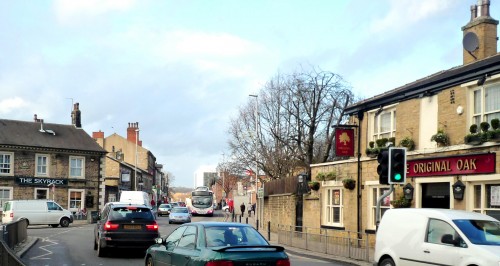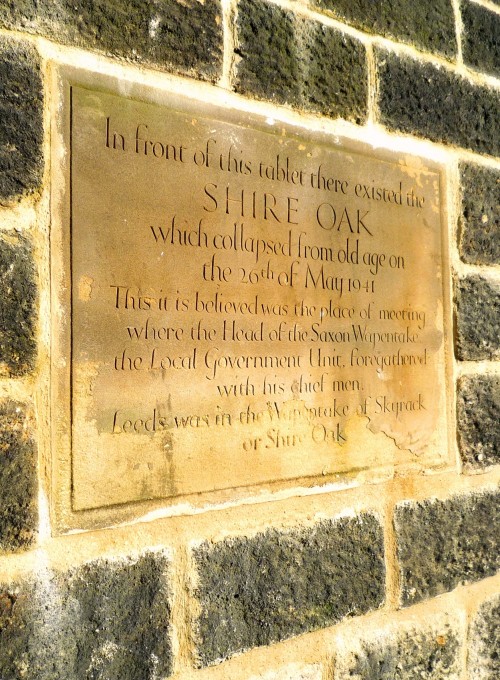
The two pubs, the Skyrack and the Original Oak, were one of the first places I got to know well when I first came to live in Leeds. It wasn’t the beer and they weren’t my nearest pubs – it was just where people met up. I came to the city knowing precisely nobody so it was natural to gravitate to a popular place where I could meet new people.
I suspect this is true of a number of young professional and students who first move to Leeds. The fame of the pubs isn’t only down to the students who make up the majority of pub goers nowadays. Both establishments were destination pubs for those looking for good ale and a pleasant environment.
What I hadn’t realised is how far back this pilgrimage to Headingley has been going on. All of it links to events in the area over the last 2000 years ago.
The name Skyrack always intrigued me. Just what is a Skyrack? No one seemed to be able to tell me. It is very much a drinker’s pub with nooks and crannies where you can talk quietly to someone else and larger areas where groups can gather.
I first met my wife in the Skyrack talking over the disco beats of the Nolan Sisters after a Champions League match had been screened in the pub.
I did find out what a “skyrack” was. It is old English for Shire Oak or “Scyre Ac”. This tree was said to have stood in the ground on the top of the hill for over a thousand years, possibly 1,600 years with some believing the tree fell as an acorn in 300AD. One thing about Oak trees is they take as long to decay as they do to grow. This one finally fell in 1941 and its fragments were sent to be carved into mementos across England.
So the Skyrack has the same name as the pub opposite. The Original Oak is well known for its beer garden. This was only expanded fairly recently when the bowling green was closed to make way for increased space for drinkers. It is a particular destination for sports fans both travelling to the Headingley Stadia and for those wanting to watch the latest fixtures on Sky. Recently it hosted the Radio 1 breakfast show and it is still a venue where you can find some of Leeds younger celebrities hanging out.

While it might be unusual for two pubs so close to each other to bear the same name, it is not so surprising when you understand the history behind the Oak tree. This place became the meeting place for the Ancient Britons who first settled here and gained increased importance after the establishment of the Danelaw by the Norse Vikings in eighth century. Although the Norse were in charge, there is evidence that the local tribes still had significant influence pushing the oak’s tradition further back in history.
The Oak must have been an imposing tree, or may be a single spared tree in the centre of the forest clearing that made up the Headingley settlement. High on a hill with views of the wider area, the site linked Ilkey and Otley (via a roman road) with Barwick-in-Elmet, Harewood, Kippax, Aberford and Leeds’ new city centre. They met with spears and swords to discuss community matters, disputes and calls to arms. Voting was made by touching swords, like the three musketeers, giving rise to the Norse term Wapentake, or weapon touch, for an administrative borough.
The politics would not have been the only reason to come to this meeting place. Socialising, games and ceremony would have been part of the plan. With the ale and mead flowing, tests of strength would have led to sports being developed on the site. Tales would be told: The story of Seleth the Sheppard who answered God’s call to building a great abbey in the Kirkstall valley below. Rumours about the establishment of a new settlement near the river Aire. The tale of Bloody civil war and how Charles I hid in the oak after rallying troops in Barwick-in-Elmet. More recently it would have been the stories of Trueman, Illingworth and Boycott or Clues, Hanley and Sinfield.
The modern pubs, at least in a historical context, are still a natural meeting point. They will change over time but the importance of the site will not. Next time you raise your glass, you have the excuse that you are just following the traditions of the oldest settlers in the region and ensuring this community lasts another millennia or two.
The North is littered with placenames that reach far back into the depths of history.
The fact that Old English survives in the modern age virtually unblemished in the name of a pub is astonishing in itself, and something my Medievel Studies tutor at Leeds used to point out eagerly when yet another jumped-up first year started to question the relevance of reading Old English.
Interesting stuff. I’ve always wondered where the name came from; and the meeting place fact only strengthens the idea o the pub as the true social hang-out. Cool – another side to a pub that’s seen better days.
Photo of the orignal Skyrack (not very interesting, admittedly…).
http://www.leodis.net/display.aspx?resourceIdentifier=1318
The 1st page of Leodis website has a vareity of photo tours, including one on pubs of central Leeds.
This is a great lesson in the importane/relevance of understanding the history of placenames.
In many places in the north you find place names beginning “Sk”, like Skeldergate in York or Skyreholm in Wharfedale which are often Old Norse versions of the earlier Anglo-Saxon names. The Norse apparently had no “sh” sound so they pronounced it “sk” instead which was their nearest equivalent, hence “Skyrack” is the Norse version of something which might have been more like “Shireack”.
Its an interesting indication of the importance of the shire oak as a meeting place and administrative centre under the Norse and later Norman rule that the wapentake within which it stood was actually named after it. Have a look at the Domesday book or the English Place Name Society volumes for West Yorkshire. Headingley Library used to have copies….there is still a library in Headingley….?
For old place names, travel along otley road and down the chevin. This derives from the northumbrian word for a ridge, which still exists in modern welsh as “cefn”. The northumbrian kingdom extended this far south before the vikings and it’s likely that the northumbrian language, or a precursor of it, was spoken around here when the romans arrived. therefore, you have a place name that may be up to 2000 years old and is certainly 1500 years old.
When you’ve finished marvelling at the history around you, go a bit further and stop in otley for a pint!
What utter rubbish. These pubs are in the suburbs so are not meet-up places, it just so happens that Headingley is a magnet for graduates in their first jobs that’s why they are popular BUT it’s only a very small part of the wider city.
Neither pubs has served or does serve decent beer. They were lousy as far back as the late 1980s.